Table of Contents
Introduction
Simulation Software Statistics: Simulation software is a versatile tool used in various industries to replicate real-world systems for analysis and decision-making.
It helps reduce costs, mitigate risks, and optimize processes. There are different types of simulation software. Including discrete event, continuous, agent-based, and Monte Carlo simulations, each suited for specific applications.
Users can model complex systems, run experiments, visualize data, and make informed decisions. Industries such as manufacturing, healthcare, finance, and aerospace rely on simulation software to improve efficiency and manage complex systems. Ongoing technological advancements continue to enhance its capabilities and broaden its applications.
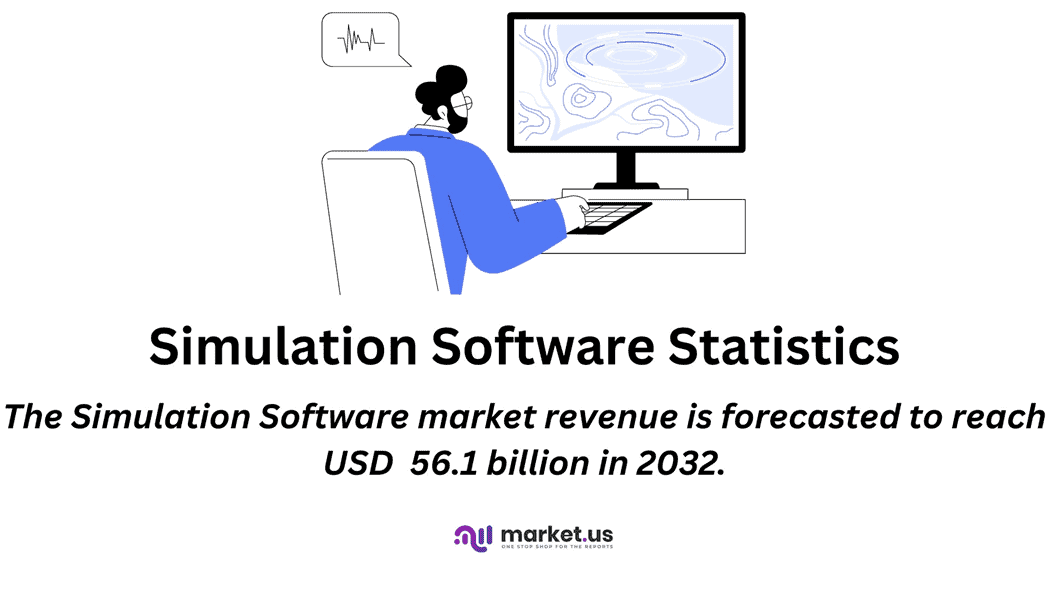
Editor’s Choice
- The simulation software market is experiencing steady growth at a CAGR of 12.9%, as evidenced by its increasing revenue.
- In 2022, the market generated $17.2 billion in revenue and is expected to rise to 56.1 billion in 2032.
- In 2022, the total market revenue stood at USD 17.2 billion, with on-premise deployments. Contributing USD 12.1 billion and cloud-based solutions generating USD 5.1 billion in revenue.
- The global simulation software market is primarily dominated by software solutions. Which accounts for a substantial 70% of the market share.
- GM Holden Australia, a branch of General Motors, experienced a 5% rise in throughput without incurring additional expenses by implementing simulation software.
- Stillwater is a mining company based in South Africa. Managed to decrease their backfill time from 2-3 hours to just 20 minutes thanks to the implementation of simulation software.
- Terminal San Giorgio Ports in Italy achieved a 20% increase in its overall terminal throughput by incorporating simulation software alongside artificial intelligence.
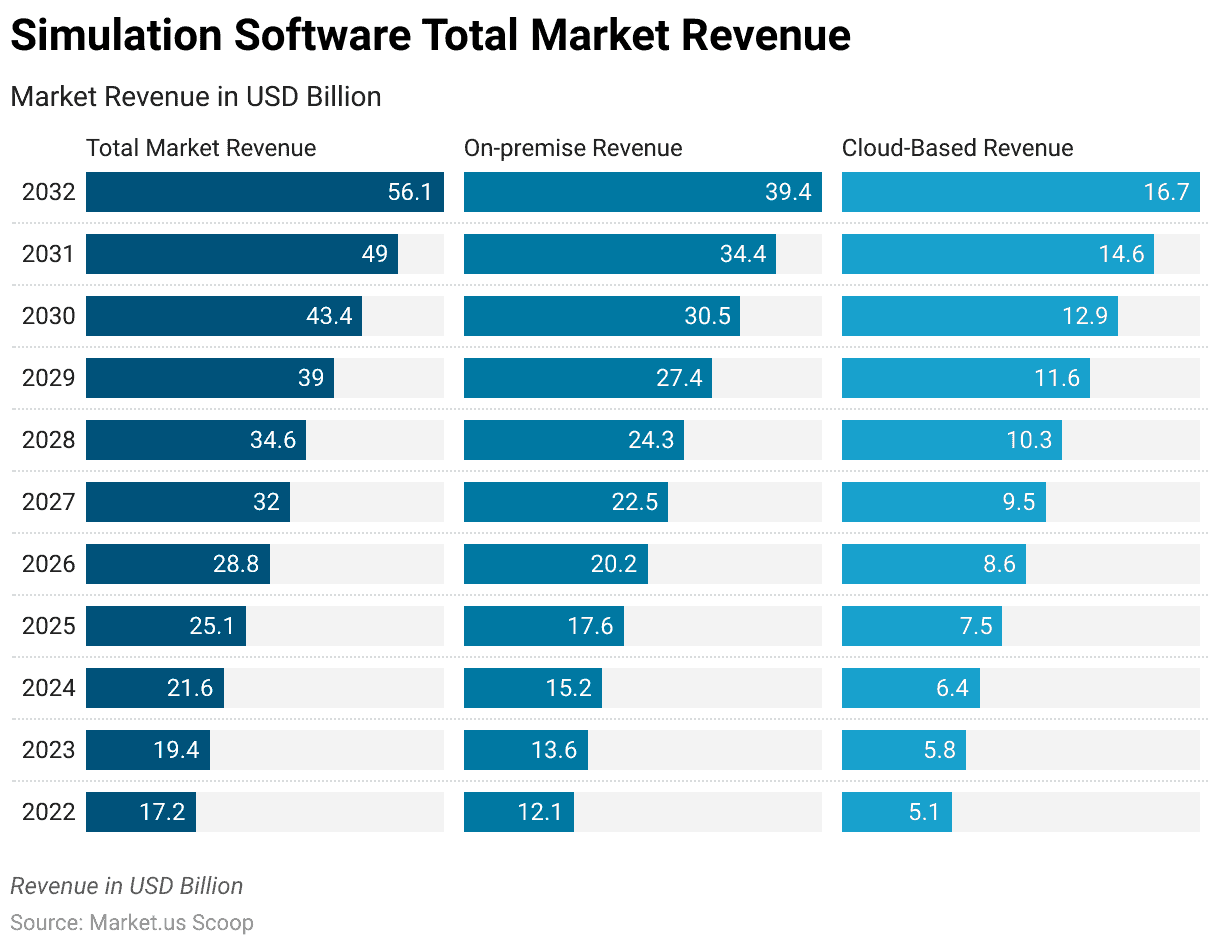
Global Simulation Software Market Statistics
Simulation Software Market Size Statistics
- The simulation software market is experiencing steady growth at a CAGR of 12.9%, as evidenced by its increasing revenue.
- In 2022, the market generated $17.2 billion in revenue, and this figure is expected to rise consistently in the coming years.
- By 2023, the revenue is projected to reach $19.4 billion. Followed by $21.6 billion in 2024, and $25.1 billion in 2025.
- The growth trajectory continues with revenues of $28.8 billion in 2026, $32.0 billion in 2027, and $34.6 billion in 2028.
- The market is set to break the $39.0 billion mark in 2029. Further expansion is expected in 2030 when the revenue is estimated to be $43.4 billion.
- As we look further into the future, the simulation software market is predicted to reach $49.0 billion in 2031 and a significant milestone of $56.1 billion in 2032.
- This data reflects a robust and promising outlook for the simulation software industry. Driven by technological advancements and increasing demand across various sectors.
(Source: Market.us)
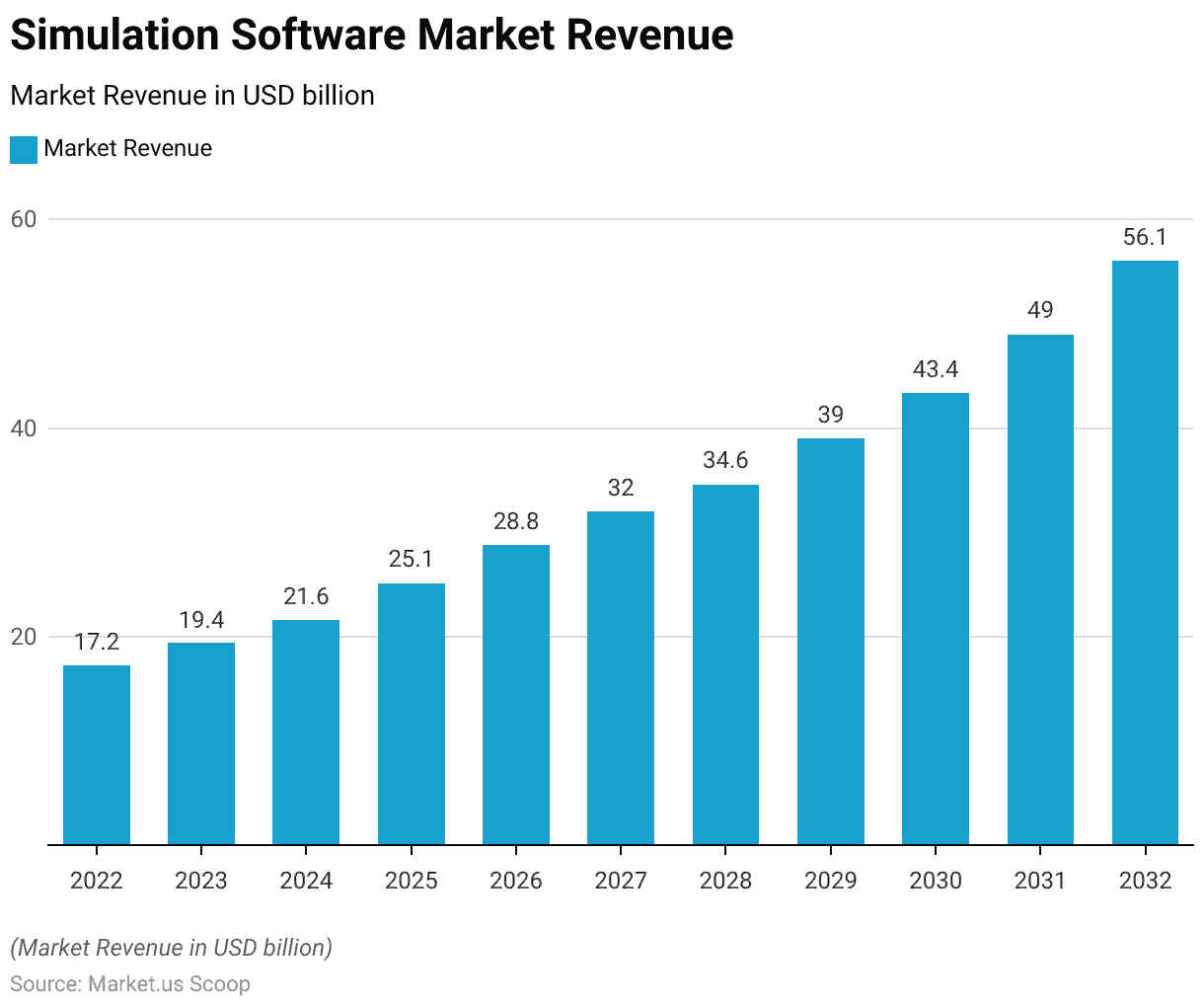
Simulation Software Market Revenue- By Deployment Mode Statistics
- The global simulation software market is poised for robust growth over the coming years. As indicated by the revenue projections from 2022 to 2032.
- In 2022, the total market revenue stood at USD 17.2 billion. With on-premise deployments contributing USD 12.1 billion and cloud-based solutions generating USD 5.1 billion in revenue.
- The market is expected to witness steady expansion, with total revenue reaching USD 56.1 billion by 2032. This growth will be driven by the increasing adoption of simulation software across various industries.
- The on-premise segment is projected to grow consistently, reaching USD 39.4 billion in 2032. While cloud-based solutions are anticipated to account for USD 16.7 billion of the market revenue in the same year.
- This shift towards cloud-based deployments highlights the growing preference for flexibility and scalability in software solutions.
- Businesses increasingly recognize the value of simulation software in enhancing decision-making and optimizing processes. The market is set to experience significant growth opportunities in the coming years.
(Source: Market.us)

Global Simulation Software Market Share – By Component Statistics
- The global simulation software market is primarily dominated by software solutions, which account for a substantial 70% of the market share.
- These software applications play a pivotal role in various industries. Ranging from aerospace and automotive to healthcare and finance, offering simulation capabilities for diverse purposes.
- Complementing the software segment are services, constituting the remaining 30% of the market share.
- These services encompass a wide spectrum of offerings, including consulting, training, maintenance, and support. To assist organizations in effectively implementing and utilizing simulation software solutions.
- This balanced combination of software and services highlights the integral role that simulation technology plays in enhancing decision-making, optimizing processes, and fostering innovation across industries worldwide.
(Source: Market.us)
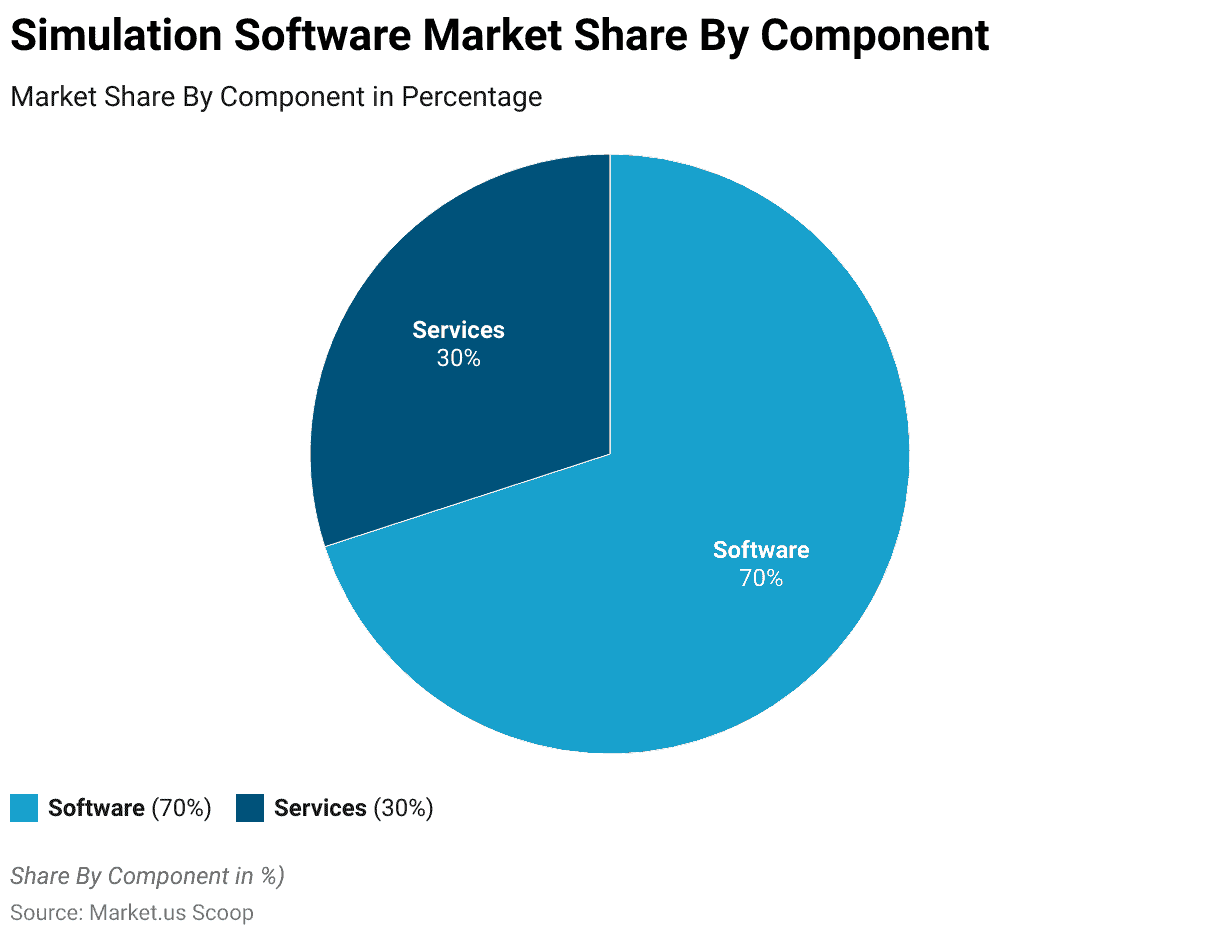
Applications of Simulation Software in Various Industries Statistics
Transportation
- The transportation industry faces numerous intricacies, spanning areas like risk management, human resources, scheduling, and maintenance.
- These complexities can be mitigated or prevented through the utilization of simulation software.
- Simulation software offers transportation companies the opportunity to enhance their resource utilization and boost overall organizational efficiency.
- For instance, GM Holden Australia, a branch of General Motors, experienced a 5% rise in throughput without incurring additional expenses by implementing simulation software.
(Source: Simul8)
Take advantage of our unbeatable offer - buy now!

Mining
- Simulation has transitioned from being a convenient tool to an essential technology in the mining sector. It is making significant advancements in this industry.
- For instance, Stillwater, a mining company based in South Africa, managed to decrease their backfill time from 2-3 hours to just 20 minutes thanks to the implementation of simulation software.
- Beyond operational optimization, simulation software also plays a crucial role in the development of more effective strategies for managing risks in mining operations.
(Source: Good Firms)
Ports & Terminals
- When it comes to cost reduction and productivity improvement in Ports and Terminals. Simulation tools prove to be the ideal choice for companies.
- For instance, Terminal San Giorgio Ports in Italy achieved a 20% increase in its overall terminal throughput by incorporating simulation software alongside artificial intelligence.
- These tools empower ports and terminals with in-depth and vital insights, enabling them to formulate plans within a risk-free environment.
- Furthermore, simulation tools are employed for risk management, internal logistics assessment, decision support, and responding to disruptions, all aimed at preventing losses.
- Through the use of simulation software, companies can efficiently manage resources for activities like yard access planning, berthing, maintenance, and logistics.
- Additionally, ports and terminals utilize simulation for container yard planning, determining stack heights, minimizing rehandling, and enhancing container throughput.
(Source: AnyLogic)
Healthcare
- Projected for 2025, the count of remote patient monitoring users may surpass 70.6 million. Leading to heightened demands and scrutiny within the healthcare sector.
- Consequently, the application of simulation in healthcare proves highly beneficial for both patients and healthcare practitioners in ensuring quality care and treatment.
- An instance of this is the Nebraska Medical Center, which effectively eliminated workflow obstacles and reduced patient and physician travel time through the utilization of simulation software.
(Source: Simio LLC)
Rail Logistics
- As of March 2023, the combined weekly rail traffic in the United States reached 458,629 carloads and intermodal units.
- This substantial traffic volume has led to a series of challenges in rail logistics, including the optimization of rail infrastructure. The enhancement of rail capacity utilization, and other related issues.
- These challenges can be effectively addressed through the application of simulation software.
- Additionally, simulation software proves valuable in tasks such as rail yard layout planning. Optimizing routes, managing fleets, and efficiently planning resources in the rail industry.
(Source: Association of American Railroads (AAR))
Oil & Gas
- The world’s need for oil may potentially surpass 106.5 million barrels per day by 2030, and there’s also a rising demand for gas.
- Consequently, the Oil and Gas sector is poised to confront several efficiency and productivity challenges.
- To address these issues, the industry is increasingly adopting simulation software within its operations.
- In this field, simulation software leverages industry-verified accuracy and streamlined processes to enhance safety, profitability, and overall site throughput.
(Source: Statista, Good Firms)
Cloud Computing Advancements for the Manufacturing Simulation Industry
- As of 2018, AWS (Amazon Web Services) reported that several industrial applications were either in the process of migrating to or being contemplated for migration to the public cloud.
- These applications encompassed a wide range of functions within the industrial sector.
- Notably, 43% of respondents were actively considering or already implementing mechanical computer-aided engineering in the cloud, while 30% were in the same position for collaborative product data management.
- Mechanical computer-aided manufacturing and manufacturing process simulation followed closely, with 28% and an undisclosed percentage, respectively.
- Additionally, other engineering functions were being explored by 21% of respondents.
- Mechanical computer-aided design had 19% of respondents currently or planning to migrate in the next two years.
- Demand planning and forecasting rounded out the list, with 18% considering or actively moving these functions to the public cloud.
- These findings shed light on the growing trend of industrial applications embracing cloud technology for improved efficiency and accessibility.
(Source: Siemens)
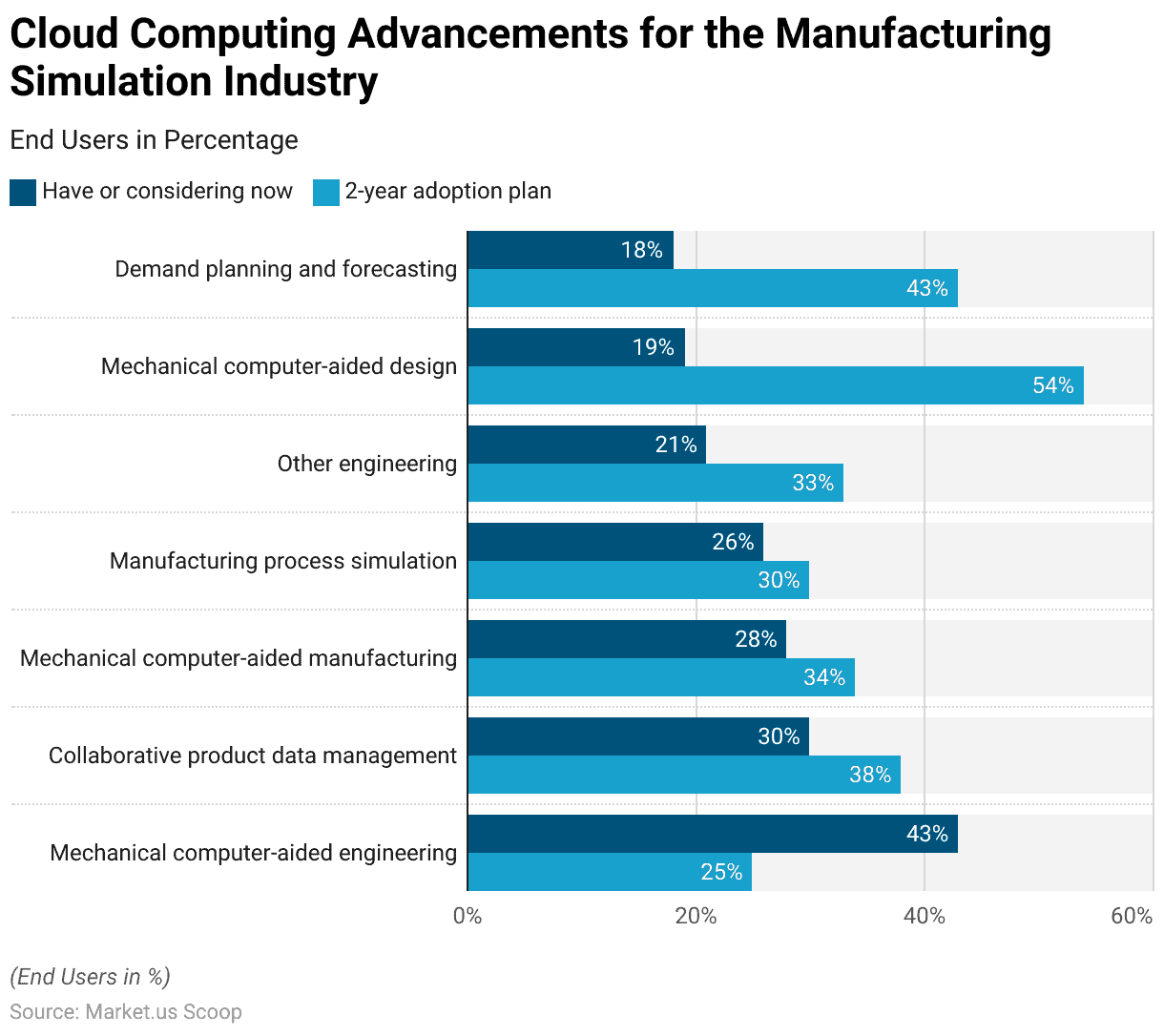
Recent Developments
Acquisitions and Mergers:
- Autodesk acquires Innovyze: In early 2023, Autodesk completed the acquisition of Innovyze, a global leader in water infrastructure simulation software, for $1 billion. This acquisition strengthens Autodesk’s capabilities in environmental and infrastructure simulations, adding value to its engineering and design portfolio.
- Ansys acquires AGI: In mid-2023, Ansys, a leader in simulation software, acquired Analytical Graphics Inc. (AGI) for $700 million. This deal enhances Ansys’ simulation capabilities, particularly in aerospace and defense applications, allowing for more complex multi-physics simulations.
New Product Launches:
- SimScale’s Cloud-Based Simulation Platform: In 2024, SimScale introduced its latest cloud-based simulation platform. Aimed at improving accessibility to high-performance simulation tools for small and medium-sized businesses. This platform offers real-time simulation capabilities in industries such as automotive, industrial, and electronics.
- Siemens’ Simcenter 2024: Siemens launched Simcenter 2024 in late 2023, featuring enhanced AI integration for predictive simulations and faster processing for multi-physics modeling. This new version is targeted at industries such as automotive, energy, and aerospace, where the demand for high-fidelity simulations is increasing.
Funding:
- Altair secures $250 million for simulation innovations: Altair, a leading simulation and AI company raised $250 million in 2023 to accelerate its development of simulation software that integrates with AI and machine learning technologies. This funding is aimed at expanding Altair’s presence in sectors like healthcare, manufacturing, and automotive.
- OnScale raises $50 million for cloud simulation: In early 2024, OnScale, a cloud-native simulation platform, secured $50 million in funding to enhance its cloud-based offerings, particularly in the fields of MEMS (Micro-Electro-Mechanical Systems) and 5G technology. The investment will be used to scale the platform and broaden its application range.
Technological Advancements:
- AI-Driven Simulations: The integration of AI and machine learning into simulation software is transforming the way simulations are conducted, offering faster and more accurate predictive models. By 2024, it is expected that over 40% of simulation software will incorporate AI-driven features, making simulation processes more efficient and reducing the need for manual input.
- Cloud-Based Simulation Solutions: Cloud adoption in simulation software is gaining momentum due to its scalability, cost-efficiency, and remote accessibility. The demand for cloud-based simulation solutions is expected to grow by 14% annually, driven by industries looking to optimize product development cycles.
Market Dynamics:
- Growth in Simulation Software Market: This growth is fueled by increasing demand across industries like automotive, aerospace, and electronics, where simulation tools are used for design optimization, testing, and cost reduction.
- Rising Demand in Automotive and Aerospace: The automotive and aerospace industries are significant drivers of simulation software adoption. By 2025, automotive and aerospace applications are expected to account for over 40% of the total simulation software market, largely due to the growing need for virtual testing and predictive maintenance.
Conclusion
Simulation Software Statistics – In summary, simulation software has become an essential and versatile tool in various industries.
Moreover, its ability to replicate real-world scenarios and analyze complex systems has made it a vital technology for optimizing operations, cutting costs, and improving productivity across sectors like manufacturing, healthcare, transportation, and oil and gas.
Beyond efficiency gains, simulation software aids in risk management, logistics analysis, and disruption response, safeguarding against potential losses.
It also plays a key role in planning container yards, resource management, and route optimization for streamlined processes.
Further, as technology continues to advance, the integration of simulation software with real-time data and artificial intelligence promises to drive innovation and solve complex challenges, making it an indispensable asset in today’s competitive landscape.
FAQs
Simulation software is a computer program that creates a digital model of a real-world system, process, or scenario to mimic its behavior and analyze its performance under various conditions.
Common types include discrete event simulation, continuous simulation, agent-based simulation, and Monte Carlo simulation, each tailored to specific applications.
Simulation software is employed in various industries, including manufacturing, healthcare, aerospace, finance, logistics, and more, for process optimization, decision support, and risk assessment.
Simulation software helps businesses reduce costs, mitigate risks, optimize processes, and make data-driven decisions without the need for physical experimentation.
Yes, simulation software is commonly used for training and education, allowing individuals to practice and learn in a controlled and risk-free environment.
Key features include modeling capabilities, experimentation tools, visualization, data integration, and support for statistical analysis.
Advances in computing power, artificial intelligence, and data analytics are expanding the capabilities of simulation software, enabling more complex and accurate simulations.
Discuss your needs with our analyst
Please share your requirements with more details so our analyst can check if they can solve your problem(s)



